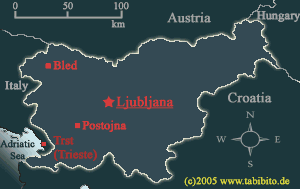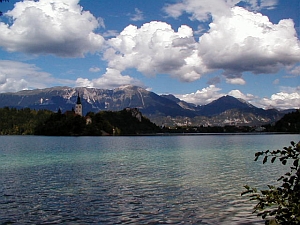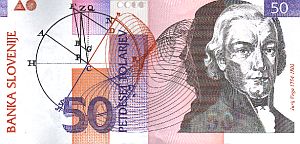|
|
|
|
|
|
 Official name:
Republika Slovenija (Republic of Slovenia). In Austria and Germany, the country is known as 'Slowenien'. The name derives
from the word Slav - most inhabitants of the country are ethnic South Slavs. Before declaring
independence, Slovenia was called 'Federal Republic of Slovenia'.
Area: 20,273 km². (equal to the size of Wales or New Jersey). Slovenia
is the smallest of the countries developing from Ex-Yugoslavia.
Population: 2.015 million * (2004). The trend is negative -
the netto growth rate has sunk below zero.
Ethnic groups:
Slovenes 93%, Serbs 2%, Croats 1.8%, Bosnians 1.1% and many others - eg Italian, Hungarian, Roma
etc. minorities (as of 2001). This means, that the Slovenian population is far more homogeneous
than the population of other Ex-Yugoslav countries.
Religion:
57.8% are Roman-Catholic, 2.4% Muslims, 2.3% Serbian-Orthodox and others, incl. atheists. (2002).
Time zone: As in middle Europe: GMT +01 hr, with daylight-saving time (+1 hour) in summer.
Language: Slovenščina (Slovenian, also called Slovene)
is the offical language. In Austria, the language is sometimes also referred to
as Windisch (Vindic). The relation to the dead language 'Wendisch', once spoken by a minority
in Central Germany, is quite obvious.
Official name:
Republika Slovenija (Republic of Slovenia). In Austria and Germany, the country is known as 'Slowenien'. The name derives
from the word Slav - most inhabitants of the country are ethnic South Slavs. Before declaring
independence, Slovenia was called 'Federal Republic of Slovenia'.
Area: 20,273 km². (equal to the size of Wales or New Jersey). Slovenia
is the smallest of the countries developing from Ex-Yugoslavia.
Population: 2.015 million * (2004). The trend is negative -
the netto growth rate has sunk below zero.
Ethnic groups:
Slovenes 93%, Serbs 2%, Croats 1.8%, Bosnians 1.1% and many others - eg Italian, Hungarian, Roma
etc. minorities (as of 2001). This means, that the Slovenian population is far more homogeneous
than the population of other Ex-Yugoslav countries.
Religion:
57.8% are Roman-Catholic, 2.4% Muslims, 2.3% Serbian-Orthodox and others, incl. atheists. (2002).
Time zone: As in middle Europe: GMT +01 hr, with daylight-saving time (+1 hour) in summer.
Language: Slovenščina (Slovenian, also called Slovene)
is the offical language. In Austria, the language is sometimes also referred to
as Windisch (Vindic). The relation to the dead language 'Wendisch', once spoken by a minority
in Central Germany, is quite obvious.
 The Slovenian language has always been treated as an independent language,
in contradiction to →Serbian and
→Croatia, which was once, despite many differences, treated
as one language called Serbo-Croatian. Slovenia, as well as Croatian, Serbian etc, belongs to the
South Slavic language group. Centuries ago, Slovenian was heavily influenced by
the German tongue. However, Slovenian was widely reformed during the 20th century. As a result,
many German words were abolished and the language became 'more Slavic' again. Same as Russian,
Slovenia has six different cases (German: 4, English: none). And it has a rare, distinctive feature:
There's not just the singular and plural, but also the so-called dual form.
The Slovenian language has always been treated as an independent language,
in contradiction to →Serbian and
→Croatia, which was once, despite many differences, treated
as one language called Serbo-Croatian. Slovenia, as well as Croatian, Serbian etc, belongs to the
South Slavic language group. Centuries ago, Slovenian was heavily influenced by
the German tongue. However, Slovenian was widely reformed during the 20th century. As a result,
many German words were abolished and the language became 'more Slavic' again. Same as Russian,
Slovenia has six different cases (German: 4, English: none). And it has a rare, distinctive feature:
There's not just the singular and plural, but also the so-called dual form.
Slovenian uses Latin script and additionally some diacritic characters, but in contradiction to Croatian, there
are only three diacritic characters, as there are:
- Č ( č ), read as the [ ch ] in [ change ].
- Š ( š ), read as the [ sh ] in [ share ].
- Ž ( ž ), read as a voiced [ sh ], close to the [ s ] in [ casual ].
Many words are closely related to Serbian and Croatian, so you won't notice a big difference when
you enter Slovenia from Croatia. This is of course limited to the first, superficial sight. Many, mostly young people
speak English fairly well. But German and partially Italian are spoken, too.
|
|
|
|
|
|
|

| |
Julian Alps near Bled
|
The eastern corner of Slovenia is rather flat - here, Slovenia has a small share of the large Pannonian plain. As everywehere, the climate
corresponds to the topography, ie it's rather Mediterranean along the coastline, slightly continental in the east and almost subalpine
in the mountains.
|
|
|
|
|
|
|
Slovenia has a long and turbulent history. The country has always been within the sphere of
influence of other nations, namely Hungary, Serbia, Italy and even Bohemia, ie the Czech Republic.
And Slovenia has not always been as small as it is today.
Large parts of the Western Balkans were first settled by Illyrian and later on by Celtic tribe. This included present-day
Slovenia. The Greeks had their share as well, founding a colony at the Adriatic Sea coast. Around the year 100 BC,
the Kingdom of Noricum was founded, but the kingdom as well as the rest of the Balkans was
soon taken over by the Roman Empire. After the Roman Empire had been divided into East and West in 395 AD,
present-day Slovenia became a part of the Western Roman Empire. Later on, the area was ruled by Germans.
It was not before the 6th century that the name-giving Slavic tribe of the
Slovenes settled in the area south of the Alps. Slovenes gradually drove out other tribes and eventually
founded the Principality of Karantania - which also included large parts of present-day Southern Austria.
Later on, a large West Slavic Empire was founded, but shortly after, at the end of the 8th century, the empire was to be crushed by
the Franks. After the invasion, many Bavarians and other German settlers moved to Slovenia, pulling the country's strings for the
next 1000 years.
During the 10th century, Hungarian nomads raided Middle Europe several times, leaving wide areas devastated (see also
→History of Hungary). This could only be brought to a halt by the German King Otto I. Ever since,
Germans heavily influenced Slovenia. After the 12th century, neighbouring Venetia (Venice) gradually grew stronger.
In the 13th century, the country was shortly conquered by the Bohemian King Ottokar Přemysl II.
(see also →History of the Czech Republic). After this, West Slovenia, ie
the area along the coast, became a part of Venetia for a very long time. From that time forth, the former Slovenian territory of the Steiermark,
Kärnten (present-day Austria) and the Krain as well as the city of →Trieste (Italy) together with
East Slovenia were ruled by Habsburg's Austria.
However, the County of Sanegg, spreading over wide parts of present-day Slovenia and
→Croatia, successfully managed to withstand Habsburg's and Venetia's supremacy
during the 14th and 15th century. At the end of the 15th century, the whole region except for the coast was reigned by the Habsburgers,
but unrests as well as occasional invasions by the Ottomans weakened the country. The Ottoman Empire eventually occupied almost all of the
Balkans, but they were not able to gain a foothold in Slovenia.
In 1809, Napoleon overran the Balkans and united wide parts of historic Slovenia and Dalmatia in order to
form the so-called Illyrian Province. This gave an impulse to the country's development. Slovenia kept
on flourishing even after it was handed back to Austria as agreed in the Congress of Berlin. This included Slovenian culture, which was
widely promoted by the local government. In the 19th century, industrialisation as well as the railroad reached the small province.
After the defeat of Austria-Hungary in World War I, the South Slav nations took their chances and founded the
Kingdom of Serbs, Croats and Slovenes, dominated by the big winner of the war →Serbia.
However, there was substantial resistance against this union in Slovenia. In 1929, the kingdom was renamed Yugoslavia.
In 1941, Yugoslavia suddenly decided to left the previously formed alliance with the fascist axis powers. This was very bad news for
Slovenia, too. Within a very short time, Slovenia was occupied and shared out between Germany (incl Austria), Hungary and Italy. As in many
other parts of Yugoslavia, resistance groups sprang up quickly. However, many resistance groups had completely different views, and so
they partially fought against each other. After the end of World War II, Yugoslavia was re-formed, now ruled by the communists.
After the death of Marshal Tito, the political situation gradually became unstable. Additionally, dissatisfaction among the people
grew stronger. Partially, this was due to the economic deterioration, although the standard of living in Slovenia as well as in
→Croatia was substantially higher than in other parts of the federation.
The sudden abolition of Kosovo's autonomy status by the government in Belgrade at the end of the 1980ies set alarm bells ringing for Slovenes.
Slovenia was the first of the Yugoslav republics to hold free and democratic elections in the year 1990. The communists
didn't have a chance, and a large majority voted for independence. The leaders were clever enough to prepare the country militarily.
On 25 June 1991, Slovenia officially declared its independence from Yugoslavia. As a first precautionary measure, the country sealed off
its border with their own troops. However, there were still Serb-dominated JNA (Yugoslav National Army) troops in the country, trying to
gain control of strategically important places in the country. The so-called 10-days War broke out,
but compared to the war in Bosnia and Croatia, combat action was limited to minor conflicts. One of the reasons of the quick solution of the
conflict was the fact, that there are almost no Serbs living in the country. Slovenia never belonged to 'Greater Serbia' - the main sphere of
Serb interests.
Slovenia had the best prerequisites for a good start - including two potent neighbours, namely Austria in the north and
Italu in the west. Agriculture as well as industry are comparatively well developed. Not to forget mass tourism. In some parts you will meet more
Austrians and Italians than locals. However, there was a short quarrel with Italy over possible recourse claims regarding the hinterland of
→Trieste (Italy). The problem was tolerably solved, and so Italy gave it's okay for the EU membership of Slovenia.
Together with nine other countries, Slovenia joined the European Union in spring 2004.
For more information on the region, esp. about Ex-Yugoslavia and the situation after 1990, see also
→Croatia, →Serbia & Montenegro,
→Bosnia-Hercegovina and →Macedonia!
|
|
|
|
|
|
|
Prologue :
As far as I could judge by what I've seen on TV and in the papers, Slovenia
seemed to be a rather untypical place among the ex-Yugoslav countries.
Indeed - a comparison with Croatia, Serbia, Bosnia, not to mention Macedonia, is
not easy. Slovenia is a small but fine country with great landscapes and few adventures for the
travelers. Nevertheless, a coincidental encounter with some hostile Neo-Fascists in
the capital has left a bitter aftertaste.
Visa: Most nationalities do not require a visa. A valid passport is all you need.
Money:
The Slovenian currency is called Tolar - the similarity to the word
"Dollar" is no coincidence, both words derive from the old German word 'Thaler'.

| |
Slovenian 50 Tolar banknote: Worth € 0.2
|
There are ATM's everywhere, accepting all common credit cards as well as
maestro and cirrus cards. The regular fee per transaction is € 4. Most banks can change cash.
Costs:
Slovenia is probably the most expensive destination in Ex-Yugoslavia - it's slightly more
expensive than →Croatia and substantially more expensive
than →Serbia + Montenegro, →Bosnia and
→Macedonia. However, the gap between prices in
the capital and places outside the capital is much smaller than in other countries.
Accommodation starts at around € 15 per night and person. Transportation is still rather cheap -
the fare for the bus from the capital to the coast is around € 9. Eating out is cheaper than in let's say Italy
or Germany. It's possible to get by on around € 40, depending on the level of activity and the hotel.
Getting there:
By bus, train plane and in summer even by boat. There are several direct flights from various destinations
in Europe, most of them landing in Ljubljana.
There are plenty of international train connections (especially to and from
→Ljubljana): There's a direct express train from Munich,
leaving at around 7 am and arriving in Ljubljana at 1 pm. The train to Munich is a night train, leaving Ljubljana at
around 11:30 pm and arriving in Munich at 6:30 in the morning. A single ticket without discount costs € 60.
When traveling from Germany, the so-called Slowenien-Sparticket is a good bargain.
There's a 25% discount on return tickets - no matter where in Germany you're starting from - and even a
50% discount for fellow travelers. Austria offers something similar.
There are also direct trains to and from →Budapest. The ride takes around
8¾ hours, the fare for the return ticket is 11,445 HUF (€ 45). Funny enough, the single ticket is more
expensive! The same express train continues to Venice (4 hrs).
If you want to go to →Trieste (Italy), you will probably have to take the
bus - there's only one train a day. It takes around 3 hrs. Most buses run via Koper. Sometimes it's necessary to
change buses there (the overall fare is 4,000 SIT). Furthermore, there is a direct train to
Thessaloniki (Greece, 25 hrs) via →Skopje and
→Belgrade (9 hrs). There are more daily trains to the latter.
There are also some direct trains to Vienna (6¼ hrs), Feldkirch (10 hrs)
as well as to Innsbruck, Villach, Klagenfurt etc. Numerous local and express trains connect Ljubljana with the
Croatian capital →Zagreb, which takes around 2¼ hours.
In summer, a ferry, to be more exactly a catamaran, crosses the Adriatic Sea from Izalo in Slovenia
to Venice. It's a very expensive pleasure, but it takes 2½ hours only.
Border crossings: There are numerous border crossings to
→Croatia, →Hungary,
Austria and Italy. Most nationalities do not require a visa for the neighbouring countries. On the train, you won't even notice
that you've just crossed the border.
Food & Drinks:
Slovenian restaurants usually offer an interesting blend of several European cuisines.
German, Austrian, Hungarian, Italian and the typical Balkan cuisine heavily influenced
Slovenia. Hence, eating out in Slovenia is definitely not boring. Most restaurants offer good service and
high quality food. As in Dalmatia, seafood is quite common in the western part and definitely worth a try,
Slovenia produces very passable wine. Furthermore, typical Balkan and Hungarian firewater
is very popular, too. Beer-lovers should definitely try Union Pivo from Ljubljana - it's an excellent lager!
|
|
|
|
|
|
|
www.sigov.si
Official website of the Slovenian government. English version available.
www.creativ.si/tourist
Nice and useful website of the Tourist Info Network. English version available.
www.websters-online-dictionary.org
Very small online dictionary.
Do you have or do you know a good website about Slovenia? Don't hesitate, let me know!
After checking it, I would love to add it to the link list.
Please note that commercial websites will be declined. For e-mail link see menu on the left.
|
|
| |